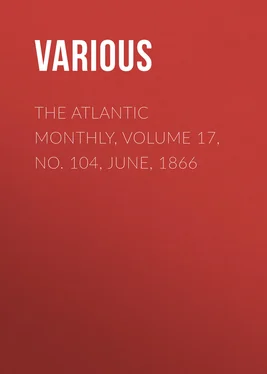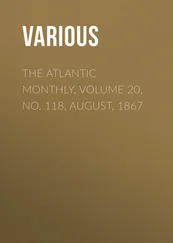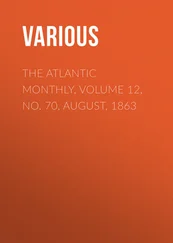Various - The Atlantic Monthly, Volume 17, No. 104, June, 1866
Здесь есть возможность читать онлайн «Various - The Atlantic Monthly, Volume 17, No. 104, June, 1866» — ознакомительный отрывок электронной книги совершенно бесплатно, а после прочтения отрывка купить полную версию. В некоторых случаях можно слушать аудио, скачать через торрент в формате fb2 и присутствует краткое содержание. Жанр: foreign_antique, periodic, foreign_edu, на английском языке. Описание произведения, (предисловие) а так же отзывы посетителей доступны на портале библиотеки ЛибКат.
- Название:The Atlantic Monthly, Volume 17, No. 104, June, 1866
- Автор:
- Жанр:
- Год:неизвестен
- ISBN:нет данных
- Рейтинг книги:5 / 5. Голосов: 1
-
Избранное:Добавить в избранное
- Отзывы:
-
Ваша оценка:
- 100
- 1
- 2
- 3
- 4
- 5
The Atlantic Monthly, Volume 17, No. 104, June, 1866: краткое содержание, описание и аннотация
Предлагаем к чтению аннотацию, описание, краткое содержание или предисловие (зависит от того, что написал сам автор книги «The Atlantic Monthly, Volume 17, No. 104, June, 1866»). Если вы не нашли необходимую информацию о книге — напишите в комментариях, мы постараемся отыскать её.
The Atlantic Monthly, Volume 17, No. 104, June, 1866 — читать онлайн ознакомительный отрывок
Ниже представлен текст книги, разбитый по страницам. Система сохранения места последней прочитанной страницы, позволяет с удобством читать онлайн бесплатно книгу «The Atlantic Monthly, Volume 17, No. 104, June, 1866», без необходимости каждый раз заново искать на чём Вы остановились. Поставьте закладку, и сможете в любой момент перейти на страницу, на которой закончили чтение.
Интервал:
Закладка:
He is not much in the books. Indeed, I am acquainted with scarcely any writer on ornithology whose head is not muddled on the subject of our three prevailing song-thrushes, confounding either their figures or their songs. A writer in the Atlantic 1 1 For December, 1858.
gravely tells us the Wood-Thrush is sometimes called the Hermit, and then, after describing the song of the Hermit with great beauty and correctness, coolly ascribes it to the Veery! The new Cyclopædia, fresh from the study of Audubon, says the Hermit's song consists of a single plaintive note, and that the Veery's resembles that of the Wood-Thrush! These observations deserve to be preserved with that of the author of "Out-door Papers," who tells us the trill of the Hair-Bird ( Fringilla socialis ) is produced by the bird fluttering its wings upon its sides! The Hermit-Thrush may be easily identified by his color; his back being a clear olive-brown, becoming rufous on his rump and tail. A quill from his wing placed beside one from his tail, on a dark ground, presents quite a marked contrast.
I walk along the old road, and note the tracks in the thin layer of mud. When do these creatures travel here? I have never yet chanced to meet one. Here a partridge has set its foot; there, a woodcock; here, a squirrel or mink; there, a skunk; there, a fox. What a clear, nervous track Reynard makes! how easy to distinguish it from that of a little dog,—it is so sharply cut and defined! A dog's track is coarse and clumsy beside it. There is as much wildness in the track of an animal as in its voice. Is a deer's track like a sheep's or a goat's? What winged-footed fleetness and agility may be inferred from the sharp, braided track of the gray squirrel upon the new snow! Ah! in nature is the best discipline. I think the sculptor might carve finer and more expressive lines if he grew up in the woods, and the painter discriminate finer hues. How wood-life sharpens the senses, giving a new power to the eye, the ear, the nose! And are not the rarest and most exquisite songsters wood-birds?
Everywhere in these solitudes I am greeted with the pensive, almost pathetic note of the Wood-Pewee. Do you know the Pewees? They are the true Flycatchers, and are easily identified. They are very characteristic birds, have very strong family traits, and very pugnacious dispositions. Without any exception or qualification they are the homeliest or the least elegant birds of our fields or forest. Sharp-shouldered, big-headed, short-legged, of no particular color, of little elegance in flight or movement, with a disagreeable flirt of the tail, always quarrelling with their neighbors and with one another, no birds are so little calculated to excite pleasurable emotions in the beholder, or to become objects of human interest and affection. The King-Bird is the best-dressed member of the family, but he is a braggart; and, though always snubbing his neighbors, is an arrant coward, and shows the white feather at the slightest display of pluck in his antagonist. I have seen him turn tail to a Swallow, and have known the little Pewee in question to whip him beautifully. From the Great Crested to the Little Green Flycatcher, their ways and general habits are the same. Slow in flying from point to point, they yet have a wonderful quickness, and snap up the fleetest insects with little apparent effort. There is a constant play of quick, nervous movements underneath their outer show of calmness and stolidity. They do not scour the limbs and trees like the Warblers, but, perched upon the middle branches, wait like true hunters for the game to come along. There is often a very audible snap of the beak as they arrest their prey.
The Wood-Pewee, the prevailing species in this locality, arrests your attention by his sweet, pathetic cry. There is room for it also in the deep woods, as well as for the more prolonged and elevated strains. His mate builds an exquisite nest of moss on the side of some shelving cliff or overhanging rock. The other day, passing by a ledge near the top of a mountain in a singularly desolate locality, my eye rested upon one of these structures, looking precisely as if it grew there, so in keeping was it with the mossy character of the rock; and I have had a growing affection for the bird ever since. The rock seemed to love the nest and to claim it as its own. I said, What a lesson in architecture is here! Here is a house that was built, but built with such loving care and such beautiful adaptation of the means to the end, that it looks like a product of nature. The same wise economy is noticeable in the nests of all birds. No bird would paint its house white or red, or add aught for show.
Coming to a drier and less mossy place in the woods, I am amused with the Golden-crowned Thrush,—which, however, is no thrush at all, but a Warbler, the Sciurus aurocapillus . He walks on the ground ahead of me with such an easy gliding motion, and with such an unconscious, preoccupied air, jerking his head like a hen or a partridge, now hurrying, now slackening his pace, that I pause to observe him. If I sit down, he pauses to observe me, and extends his pretty ramblings on all sides, apparently very much engrossed with his own affairs, but never losing sight of me. But few of the birds are walkers, most being hoppers, like the Robin. I recall only five species of the former among our ordinary birds,—the one in question, the Meadow-Lark, the Tit-Lark, the Cow-Bunting, and the Water-Wagtail (a relative of the Golden-Crown).
Satisfied that I have no hostile intentions, the pretty pedestrian mounts a limb a few feet from the ground, and gives me the benefit of one of his musical performances, a sort of accelerating chant. Commencing in a very low key, which makes him seem at a very uncertain distance, he grows louder and louder, till his body quakes and his chant runs into a shriek, ringing in my ears with a peculiar sharpness. This lay may be represented thus: "Teacher teacher, teacher, teacher teacher!"—the accent on the first syllable and each word uttered with increased force and shrillness. No writer with whom I am acquainted gives him credit for more musical ability than is displayed in this strain. Yet in this the half is not told. He has a far rarer song, which he reserves for some nymph whom he meets in the air. Mounting by easy flights to the top of the tallest tree, he launches into the air with a sort of suspended, hovering flight, like certain of the Finches, and bursts into a perfect ecstasy of song,—clear, ringing, copious, rivalling the Goldfinch's in vivacity, and the Linnet's in melody. This strain is one of the rarest bits of bird-melody to be heard. Over the woods, hid from view, the ecstatic singer warbles his finest strain. In this song you instantly detect his relationship to the Water-Wagtail ( Sciurus Noveboracensis ),—erroneously called Water-Thrush,—whose song is likewise a sudden burst, full and ringing, and with a tone of youthful joyousness in it, as if the bird had just had some unexpected good-fortune. For nearly two years this strain of the pretty walker was little more than a disembodied voice to me, and I was puzzled by it as Thoreau by his mysterious Night-Warbler, which, by the way, I suspect was no new bird at all, but one he was otherwise familiar with. The little bird himself seems disposed to keep the matter a secret, and improves every opportunity to repeat before you his shrill, accelerating lay, as if this were quite enough and all he laid claim to. Still, I trust I am betraying no confidence in making the matter public here. I think this is pre-eminently his love-song, as I hear it oftenest about the mating season. I have caught half-suppressed bursts of it from two birds chasing each other with fearful speed through the forest.
Turning to the left from the old road, I wander, over soft logs and gray yielding débris , across the little trout brook, until I emerge in the Barkpeeling,—pausing now and then on the way to admire a small, solitary white flower which rises above the moss, with radical, heart-shaped leaves, and a blossom precisely like the liverwort except in color, but which is not put down in my botany,—or to observe the ferns, of which I count six varieties, some gigantic ones nearly shoulder-high.
Читать дальшеИнтервал:
Закладка:
Похожие книги на «The Atlantic Monthly, Volume 17, No. 104, June, 1866»
Представляем Вашему вниманию похожие книги на «The Atlantic Monthly, Volume 17, No. 104, June, 1866» списком для выбора. Мы отобрали схожую по названию и смыслу литературу в надежде предоставить читателям больше вариантов отыскать новые, интересные, ещё непрочитанные произведения.
Обсуждение, отзывы о книге «The Atlantic Monthly, Volume 17, No. 104, June, 1866» и просто собственные мнения читателей. Оставьте ваши комментарии, напишите, что Вы думаете о произведении, его смысле или главных героях. Укажите что конкретно понравилось, а что нет, и почему Вы так считаете.












